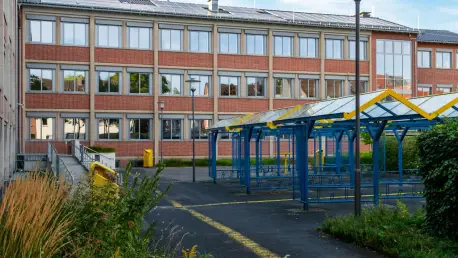Imagine walking into a school building where the air is thick with mold, the ceilings leak during every rainstorm, and the heat or air conditioning fails to function for weeks on end, creating an environment unfit for learning or working. This is the harsh reality faced by staff and students in Montgomery County Public Schools (MCPS) in Maryland, where aging infrastructure and neglected maintenance have sparked outrage among educators, parents, and community members. Reports of health issues like asthma flare-ups and persistent headaches have become alarmingly common, painting a grim picture of facilities that are failing those who rely on them most. The mounting frustration has led to a unified call for urgent action to address these intolerable conditions, as the district struggles with systemic challenges in maintaining over 200 school buildings, many of which have not seen significant upgrades in decades. This growing crisis demands a closer look at the scope of the problem and the steps needed to ensure safe, functional learning environments.
Voices of Concern Rise in the Community
Health Impacts of Deteriorating Facilities
The dire state of school buildings in MCPS has taken a significant toll on the health of both staff and students, with personal accounts shedding light on the severity of the situation. Administrative secretary Elida Pineda, based at the Carver Educational Services Center, has shared how poor air quality worsens her asthma, forcing her to rely on an inhaler daily just to get through her workday. Similarly, complaints of persistent coughs, headaches, and other respiratory issues have surfaced across multiple schools, directly linked to mold growth and inadequate ventilation systems. These health concerns are not isolated incidents but rather widespread problems that disrupt the well-being of entire school communities. The physical environment, meant to nurture education, has instead become a source of chronic discomfort and illness, raising serious questions about the long-term effects on those exposed to such conditions day after day.
Beyond individual health struggles, the broader implications for student learning and staff performance are impossible to ignore. Parents like Risha George from White Oak Middle School have described unbearable heat during school events due to malfunctioning HVAC systems, highlighting how these conditions create daily challenges for everyone in the building. When temperatures soar or plummet without proper climate control, concentration falters, and the educational process suffers. Additionally, flooded bathrooms and pest infestations compound the problem, creating unsanitary spaces that further degrade the school experience. The cumulative effect of these issues points to an urgent need for intervention, as the current state of facilities undermines the fundamental purpose of schools as safe havens for growth and development.
Unified Call for Immediate Solutions
At a recent Montgomery County school board meeting, a powerful consensus emerged among SEIU Local 500 members, parents, and PTSA representatives, all demanding swift and substantial action to rectify the crumbling infrastructure. Pia Morrison, president of SEIU Local 500, passionately argued that no staff member should have to risk their safety to work in such deplorable conditions, reflecting a shared sentiment of frustration with the district’s slow response. This collective voice underscores a deep-seated urgency, as stakeholders reject the idea of waiting for gradual improvements in favor of immediate, impactful investments. The message is clear: the time for temporary fixes has passed, and comprehensive solutions must take precedence to protect the health and dignity of school communities.
The intensity of this demand is fueled by years of neglect, with many feeling that their concerns have been repeatedly sidelined by bureaucratic delays and insufficient funding. Community members are not just asking for repairs but for a fundamental shift in how maintenance priorities are handled, ensuring that schools are treated as essential spaces rather than afterthoughts in budget discussions. Reports of ongoing issues, even in facilities undergoing remediation like Carver Educational Services Center, add to the skepticism about the district’s ability to deliver meaningful change without external pressure. This growing unrest highlights a critical disconnect between the lived experiences of those in MCPS buildings and the pace of administrative action, amplifying the need for transparency and accountability in addressing these long-standing grievances.
Systemic Challenges and District Response
Aging Infrastructure and Maintenance Backlogs
Delving into the root causes of the facilities crisis in MCPS reveals a daunting reality of aging infrastructure compounded by systemic shortcomings, as outlined in the district’s 2026 Comprehensive Maintenance Plan. Many of the over 200 school buildings have gone decades without major capital improvements, leaving them vulnerable to pervasive issues like leaks, mold, and broken HVAC systems. District data paints a stark picture, showing that only 37% of nearly 10,200 preventive maintenance work orders were completed within a month in the current fiscal year, falling far short of the target of 15,000. This backlog, exacerbated by budget constraints, inflation, and a shortage of skilled trade workers, illustrates the immense challenge of keeping up with the needs of an expansive school system under strain.
Financial limitations further complicate the situation, with funding for maintenance consistently below industry standards, as acknowledged in official reports. The combination of deferred projects and rising costs means that even basic repairs often remain unaddressed for extended periods, allowing small problems to escalate into major hazards. This cycle of neglect not only jeopardizes the safety of school environments but also erodes trust in the district’s capacity to manage its resources effectively. As the maintenance deficit grows, the gap between what is needed and what is provided widens, placing additional pressure on already overburdened staff and facilities teams to prioritize emergencies over long-term planning, perpetuating a reactive rather than proactive approach.
District Commitments and Community Skepticism
Superintendent Thomas Taylor has publicly recognized the severity of the issues plaguing MCPS facilities, pledging to tackle them with a sense of urgency, though tangible progress remains a point of contention. Specific efforts, such as mold remediation at Carver Educational Services Center scheduled to continue through mid-November, demonstrate some action, but staff members like Pineda continue to express concerns about ongoing health impacts despite these measures. District spokesperson Liliana López has indicated updates for affected staff, yet broader strategies for other schools remain vague, fueling parental demands for clearer timelines and transparency. The gap between promises and visible results has left many stakeholders questioning whether the district’s commitments will translate into the sweeping changes needed.
This skepticism is rooted in a history of delayed responses and perceived inaction, with community members wary of relying on assurances without concrete evidence of improvement. The scale of the challenge—combining underfunding, workforce shortages, and an extensive backlog—suggests that isolated fixes may fall short of addressing the systemic nature of the problem. As frustration mounts, there is a pressing need for the district to bridge the divide between rhetoric and reality by outlining detailed, actionable plans that prioritize the most critical repairs while building toward sustainable maintenance practices. Only through such efforts can trust be restored, ensuring that the health and safety of students and staff are no longer compromised by the state of their surroundings.
Path Forward: Building a Better Future
Reflecting on a Persistent Struggle
Looking back, the facilities crisis in Montgomery County Public Schools stood as a stark reminder of the consequences of prolonged neglect, where aging buildings and insufficient resources collided with the urgent needs of students and staff. Health hazards like mold and poor air quality, coupled with maintenance backlogs, had created an environment that hindered education and well-being, leaving a lasting impact on the community. The unified outcry from staff, parents, and union representatives at board meetings echoed a profound frustration with the slow pace of change, highlighting a critical moment when the district’s response was put to the test. This struggle revealed not just physical disrepair but a deeper systemic failure to prioritize the spaces where future generations learn and grow.
Charting the Next Steps
Moving ahead, resolving these deep-rooted issues demands a multifaceted strategy that goes beyond temporary repairs to embrace long-term investment and accountability. A significant increase in funding for maintenance, aligned with industry standards, must be secured to address the backlog of work orders and prevent further deterioration of facilities. Collaborating with skilled trade programs to bolster the workforce could help expedite critical repairs, while transparent reporting on progress would rebuild community trust. Additionally, prioritizing health and safety assessments in every school can guide resource allocation to the most pressing needs. By committing to a comprehensive overhaul of maintenance practices, MCPS has the opportunity to transform its schools into environments that truly support education, ensuring that no student or staff member faces the hazards of neglect again.









